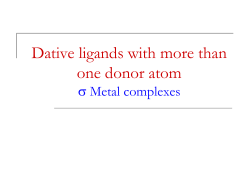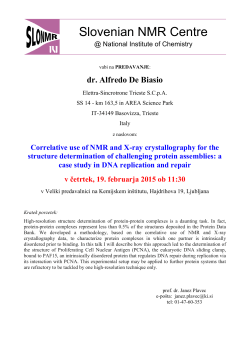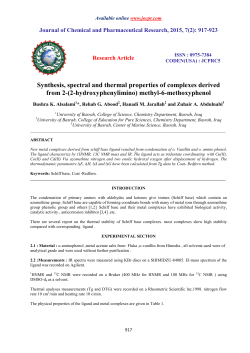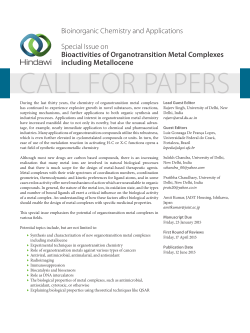
Synthesis, Electrocatalytic Behavior and Biological Evaluation of
Canadian Chemical Transactions Year 2015 | Volume 3 | Issue 2 | Page 184-194 Ca Research Article DOI:10.13179/canchemtrans.2015.03.02.0189 Synthesis, Electrocatalytic Behavior and Biological Evaluation of Trimetallic Macrocyclic Complex with Two Different Bridging Ligands Mohammad Maqbool Dar1, Urvashi Singh1, Hammad Alam2, Nikhat Manzoor2, Shaeel Ahmed Al-Thabaiti3 and Athar Adil Hashmi1* 1 Department of Chemistry, Jamia Millia Islamia University, New Delhi-110025 Department of Bioscience, Jamia Millia Islamia University, New Delhi-110025 3 Department of Chemistry, Faculty of Science, King Abdul Aziz University, P.O. Box 80203,Jeddah 21416, Saudi Arabia. 2 * Corresponding Author: Email: dr.aahashmi@yahoo.co.in Ph:+919868523358 Received: March 26, 2015 Revised: April 27, 2015 Accepted: April 27, 2015 Published: April 28, 2015 Abstract: This work presents the synthesis and electrocatalytic behavior of unique heterometallic macrocyclic complexes derived from deprotonated cobalt dimethylglyoxime with axially bridged diethanolamine. The electrocatalytic behavior of macrocyclic complexes was tested by cyclic voltammetry and chronoamperometry. Multi-electron, reversible, diffusion controlled and metal-based reduction properties of the complexes show possible application of the complexes as an electrocatalyst for hydrogen evolution in aqueous as well as non aqueous solution. The complexes are easily electrodeposited on the glassy carbon electrode during the repetitive cycles, a very useful feature, for application in fabrication of thin films. Electrocatalytic activities change irregularly with the pH of the solution. Moreover, the catalytic activity of the complexes enhanced significantly, when the complexes were incorporated into the Nafion polymeric matrix as it decreases the overpotential of hydrogen evolution reaction on the glassy carbon electrode up to 0.32 V with augmenting hydrogen discharge current. The complex was screened on Candida albicans ATCC 90028 by determining MICs (Minimum inhibitory concentrations) and inhibition in solid media (Disc diffusion assay). Keywords: Dimethylglyoxime, Coordination polymer, Electrocatalyst, Hydrogen overpotential, Electrodeposition, Candida albicans ATCC 90028, MICs. 1. INTRODUCTION The future of energy supply depends on innovative design of cheap, sustainable and efficient systems for conversion and storage of renewable energy sources. The production of hydrogen through water splitting seems a promising solution for sustainable energy cycles that minimize carbon dioxide emissions [1], but running reaction electrolytically is challenging as it involves two separate multielectron redox processes, a four electron oxidation and a two electron reduction [2]. Also the use of precious metals as electrodes to perform both the hydrogen evolution reaction (HER) and the oxygen evolution reaction (OER), impedes their implementation on a global scale [3-14]. Since the electron or hole Borderless Science Publishing 184 Canadian Chemical Transactions Year 2015 | Volume 3 | Issue 2 | Page 184-194 Ca H3C H3C CoCl 2.6H 2O + N CH3 OH 2 HO N O CH3 N N O - 2+ Co H O - N H N H3C O CH3 Diethanol amine H3C O HO CH3 N NH N O - 2+ H Co H O - N OH2 OH O N CuCl 2.4H 2O CH3 H3C H3C CH3 + N HO H2O O Cu N N OH O 2+ - Co O N Cu N H3C OH2 O OH2 H2O - OH2 CH3 Scheme 1: Schematic representation of synthesis of complex transfers directly to water and produces extremely high energy intermediates, therefore the process requires catalysts to avoid formation of these species [15, 16]. Despite the recent advances in this field, the design of catalysts with high activity and stability in aqueous media at minimum overpotential is a real challenge [18]. Most of the previously described hydrogen producing systems are biomimetic metal sulphur clusters that mimic the hydrogenase enzyme [19], imines and clathrochelates [20], cobalt and nickel metallocenes and phosphenes [21] as well as cobalt oximes [22]. The mechanistic studies suggested that the proton reduction in these systems involves electron transfer from electrochemically generated reactive cobalt (I) species. Due to unfavorable thermodynamics of this electron transfer, the resulting overpotential decreases rate of catalysis [23]. One of the possible ways to decrease the overpotential of proton reduction and to make this process thermodynamically favorable is variation of Borderless Science Publishing 185 Canadian Chemical Transactions Year 2015 | Volume 3 | Issue 2 | Page 184-194 Ca substituent at dioxamate fragments of the cage ligands. This allows tuning of the potentials of the metal centered redox process [24]. As a result, the potential of electrocatalytic hydrogen production can be controlled. Therefore it is possible to design suitably substituted cobalt dimethylglyoxime complexes that electrocatalyze the proton reduction at potential close to 0 V vs. RHE in this system. In this work, we report the electrochemical and electrocatalytic behavior of newly synthesized binuclear trimetallic macrocyclic complex derived from cobalt dimethylglyoximate with axially bridging diethanolamine. Furthermore, the catalysts showed both hydrogen evolution and oxidation, confirming their low overpotential for hydrogen production. 2. EXPERIMENTAL SECTION 2.1 Materials and Methods All the chemicals were of AR Grades and used without further purification. Elemental analyses (percentage of carbon, hydrogen and nitrogen) were performed using a Vario EL elemental analyzer. Infrared spectra (4000-400 cm-1) were recorded at 250C using a Perkin Elmer 1750 FTIR spectrophotometer (CT 06859 USA) using KBr pellets in the range of 4000-400 cm-1. Electronic spectra (200-1200 nm) were obtained at 250C using a Perkin Elmer Lambda-40, double-beam UV-Visible spectrophotometer, where water was used as medium as well as reference. Cyclic voltametry was carried out on Cyclic voltammetry (CV) was performed using an Autolab Potentiostat/Galvanostat 302N instrument Cyclic voltammeter using three electrode system. Stock cultures of the microorganisms were maintained on nutrient agar slants and stored at 4°C. Candida albicans ATCC 90028 was grown in YPD media respectively at 37 ºC in orbital shaker at 200 rpm (REMI CIS 24 BL). YPD medium consisted of 2% (w/v) glucose, 2% peptone, and 1% yeast extract (Hi Media, India). 2.2 Synthesis of complex [CoCu2(C12H33N5O15S)] An ethanolic solution of cobalt chloride hexahydrate (1 mmol) was added drop wise with constant stirring to ethanolic solution of dimethylglyoxime (2 mmol). The stirring was continued for 30 min. at about 700C followed by dropwise addition of (1 mmol) ethanolic solution of diethanolamine. The resulting mixture was refluxed for 3 hrs. The brown reddish mixture was then cooled and an ethanolic solution of CuCl2.4H2O (2 mmol) was added. The mixture was further refluxed for 2 hrs. at 500C. The hot mixture was then filtered and (1 mmol) aqueous solution of ammonium sulphate was added to it. The filtrate was kept in a CaCl2 desiccator. Dark reddish single crystals suitable for X-ray data collection were obtained from the filtrate after a few days. Yield: 50%; mol. Wt. 705.49 gmol-1; dark reddish crystals; anal. Calc. for [CoCu2(C12H33N5O15S)](%): found(calculated): C, 20.20% (20.43%); H, 4.39% (4.43%); N, 9.90% (9.92%); S, 4.50% (4.54%); IR (KBr pellets, cm-1): 1125(N-O), 490(Cu-O, oxime oxygen); ESI-MS (m/z) for [M-(SO4+4H2O+Cl+DEA+2H+)]: 410.4. Found: 410.7; λmax. = 815nm. 2.3 Solution Stability A quantitative estimation of the stability of the complexes at physiological pH was obtained by monitoring their UV-Vis spectra in aqueous solutions of PBS at pH 7.4. Over a period of 24 h. the solutions of the complexes (10-4 M) were prepared in aqueous solutions of PBS at pH 7.4. The hydrolysis profiles of the complexes were assessed by recording their electronic spectra over 24 h at 25oC [25]. Borderless Science Publishing 186 Canadian Chemical Transactions Year 2015 | Volume 3 | Issue 2 | Page 184-194 Ca 80 %T 70 60 50 40 4500 NB 3750 3000 2250 1500 750 1/cm Figure 1: FT-IR of compound 2.4 Biological Screening 2.4.1 Minimal inhibitory concentration (MIC) The minimal inhibitory concentration (MIC) is the lowest concentration of the test compound that causes inhibition of visible growth (turbidity). MIC80 was determined in vitro in liquid medium by the broth micro dilution method as per the guidelines of CLSI reference document M27-A3 [26] for fungi. Fluconazole was included as positive control in this study. In addition to this, a drug-free control was also included. 2.4.2 Disk diffusion assay The assay was performed as discussed previously [27]. Briefly, strains were inoculated into liquid media and grown overnight at 37ºC. Cells were then washed three times with distilled water and approximately 1×105 cells/ml were inoculated into half-strength molten agar media at 42ºC and poured into 100 mm diameter petri-plates. After the top layer had solidified; sterile paper discs (4 mm) were impregnated with the test compounds and placed on the agar surface. After incubation at 37ºC for 48 h, the size and pattern of the growth inhibition zone around the disc on agar were evaluated. 3. RESULTS AND DISCUSSION The coordination complex was synthesized by condensation of deprotonated cobaltdimethylglyoxime containing diethanolamine as axial ligands with copper chloride [scheme 1]. The metal complexes were obtained as dark reddish crystals in good yield (50-55%). The complex was airstable solid, soluble in water and insoluble in other solvents. The complex was characterized by elemental analysis, IR, ESI-MS, UV-visible spectroscopy and conductivity measurements. 3.1 FT-IR spectrum FT-IR of the complex was recorded as KBr disc. The medium intensity band in the range of 10101020 cm-1 due to ν(N-O) and absence of broad peak at about 3400cm-1 is consistent with absence of Borderless Science Publishing 187 Canadian Chemical Transactions Year 2015 | Volume 3 | Issue 2 | Page 184-194 Ca hydrogen bonded OH and hence presence of deprotonated cobalt oxime. The sharp peak at 490 cm-1 indicates coordination of dimethylglyoxamato dianion with copper. Medium to high intensity band at 3150 cm-1 is consistent with the presence of water molecules coordinated to terminal copper ions. 3.2 ESI mass spectrum ESI-MS was recorded in positive ion mode and indicates the evidence of the formation of the binuclear trimetallic coordination complex [Figure 1]. The (M+1) peak was not observed. However many fragments were observed in the spectrum which characterize the composition of complex. The peaks corresponding to fragments with general formula [M-SH8O8Cl(DEA)+2H+)], [M-SH8O10Cu(DEA)] at m/z 410.7 and 255.9 respectively were observed (where DEA=diethanolamine and M=CoCu2C12H31N5O14SCl). The base peak was observed at m/z 97.4 which corresponds to the fragment [dimethylglyoxime-H2O]. WATERS, Q-TOF MICROMASS (LC-MS) SAIF/CIL,PANJAB UNIVERSITY,CHANDIGARH IMTIYAZ B-1- 24 (0.269) Cm (12:47) TOF MS ES2.65e4 97.0 26541 % 100 97.4 5087 99.0 2537 155.9 1177 251.9 2364 250.8 1155 175.9 1202 255.9 2700 257.9 1437 410.7 798 0 m/z 60 80 100 120 140 160 180 200 220 240 260 280 300 320 340 360 380 400 420 440 460 480 500 Figure 2: ESI-MS of complex 3.3 Molar conductivity Molar conductance measurement of the complex was carried out in double distilled water at room temperature. Molar conductance value for 10-3 M solution of complex was 87.5 Ω1cm2M-1. This value is in accordance with their 1:1 nature [28-30]. 3.4 UV-Vis spectrum UV-Vis of complex in water has been measured in 200-1200 nm range. In addition to the highly intense ligand centered n→σ* transition at 213 nm and π→π* transition at 266 nm, two other broad bands were observed at 850 nm and 1035 nm [Figure 2]. On the basis of low extinction coefficient and relative broadness, the broad maximum at 850 nm and a relatively weak absorption feature at 1035 nm are Borderless Science Publishing 188 Canadian Chemical Transactions Year 2015 | Volume 3 | Issue 2 | Page 184-194 Ca assigned to ligand field (d-d) transitions occurring at terminal Cu (II) centers. The energy of these transitions is insensitive to different solvents, hence lending further support to d-d nature of these broad bands. Absorption bands with comparable features have been previously assigned to high spin copper (II) complexes having square pyramidal structure with considerable distortions [31]. Figure 3: UV-Vis of complex without buffer with buffer 0.03 % Absorbance 0.02 0.01 0.00 -0.01 400 600 800 1000 1200 wave length(nm) Figure 4: Solution Stability of complex Borderless Science Publishing 189 Canadian Chemical Transactions Year 2015 | Volume 3 | Issue 2 | Page 184-194 Ca 3.4 Solution stability Aquation is an important process for the action of a large number of therapeutically active drugs. UV-Vis absorption spectroscopy is often used for the solution stability studies of complex at physiological pH. Complex displayed similar spectra in PBS with no shifts in their bands shown in figure 3 after 24 h and also resisted precipitation over this time period. All these observations indicated the robust nature of the complex [25]. 3.5 Cyclic Voltameter Cyclic Voltameter was carried out using three electrode system and is shown in figure 4. In water with 0.1 M acetic acid, reversible reductions were observed for the CoIII/II couple at -0.06 V vs SCE and for the CoII/I couple at -0.38 V vs SCE. Addition of TsOH.H2O (0.15 mM) to an unstirred solution of (0.1 M) acetic acid in water produced a catalytic wave at a potential close to the position of E°(CoII/I) for complex. At low acid concentrations, the catalytic wave had a peak-like shape, but for higher acid concentrations the current approached a plateau at potentials more negative than E°(CoII/I). The potential at which catalysis took place remained nearly constant with increasing acid concentration. No catalytic waves were observed at potentials near the E°(CoIII/II), consistent with the fact that this potential was significantly more positive than the thermodynamic potential for hydrogen evolution using tosic acid as the proton source. Similar behaviour was observed when HBF 4.Et2O was used as the proton source. Hence, complex is a catalyst for electrochemical H2 evolution in acidic aqueous solutions and the catalysis is associated with reduction of the Co(II) complex to its Co(I) state. 50mV 0.00025 0.00020 0.00015 50mV B 0.00010 0.00005 0.00000 -0.00005 -0.00010 -0.00015 -0.6 -0.4 -0.2 0.0 0.2 0.4 0.6 0.8 1.0 1.2 A Figure 5: Cyclic Voltameter of complex 3.6 Antifungal Acivity 3.6.1 Minimum Inhibitory Concentration (MIC80) The Minimum Inhibitory Concentration was defined as the lowest concentration of the complex that causes 80% decrease in absorbance (MIC80) compared with that of the control (no test compound) [Table 1]. The MIC80 of metal complex and standard drugs were determined against Candida albicans ATCC 90028 broth dilution method (BDM). The complex has MIC80 160 µg/ml. Borderless Science Publishing 190 Canadian Chemical Transactions Year 2015 | Volume 3 | Issue 2 | Page 184-194 Ca Table 1. In vitro antimicrobial activity of complex. Test agents MIC (µg/ml) C. albicans ATCC 90028 160 2.5-7.5 B1 Complex Fluconazole (standard drug) Table 2. Disk diffusion assay of C. albicans ATCC 90028 showing inhibition in the presence of synthesized complex. S.No. 1. 2. 3. 4. Test concentration (µg) 200 400 1000 2000 Zone of Inhibition (mm) B1 Fluconazole (Complex) * * 8 14 *no inhibition halo 22 * * * Figure 6. Disk diffusion assay of C. albicans ATCC 90028 showing zones of inhibition in the presence of complex [B1]. The concentration of the test compounds ranged from 200-2000 µg per disk. Fluconazole (FLU) (2.5-7.5 µg) was used as a positive control. 3.6.2 Disc Diffusion Assay Synthesized compounds were investigated for their antimicrobial activity by agar diffusion method (Table-2). Antifungal activity (in vitro) of the complex was studied against Candida Albicans ATCC 90028 at the concentration range of 200μg/ml and 2000μg/ml (10 fold more than MIC). At higher concentration the complexe show significant antimicrobial activity against the tested pathogens. Higher concentrations of the complexe was used to get visible results. At higher concentration (2000μg/ml) the highest zone of inhibition i.e. 14 mm was measured in Candida albicans when treated Borderless Science Publishing 191 Canadian Chemical Transactions Year 2015 | Volume 3 | Issue 2 | Page 184-194 Ca complex respectively [figure 5]. The result showed that, in case of solvent control disc no zone of inhibition was observed so as far as our study is concerned 10% DMSO, as a solvent is having no effect on the tested organisms. Results obtained demonstrated that the ability to kill Candida species is dependent on the concentration of the test compound. The tested Candida isolate used in this study showed high degree of sensitivity for metal complexes as is evident from the large zones of inhibition. Hence we can effectively conclude here that whole of the antifungal effect is due to the different concentration of the metal complex used in this study. This result is significant as the conventional drug fluconazole is fungistatic and hence leads to antifungal drug resistance. Of course the complexation of the metal ion has brought about enhancement in activity. Our results are also supported by the study which shows that metal ions are thought to reduce polarity and, thereby, allowing effective attachment of complexes with the cell membranes creating pores leading to the loss of essential cell ingredients and consequent cell death [32]. 4. CONCLUSION: The synthesis of heterotrimetallic complex has been described. The complexes were obtained in good yield. The complex may attributed to square planar geometry. The structure of the complex was proposed mainly on the basis of spectroscopic data. The MICs obtained gave a good indication of the overall antifungal effectiveness of each test compound. This indicates that complex displayed anticandidal activities against Candida ablicans. Although it was still less active than fluconazole, it can be used as a good starting point for further optimizations. The complex is a catalyst for electrochemical H2 evolution in acidic aqueous solutions and the catalysis is associated with reduction of the Co(II) complex to its Co(I) state. The future of this field lies in gaining a better understanding of the fundamental transformations occurring at heterobimetallic centers and assessing the independent roles of each metal and/or the polar metal-metal bonds in reactivity. ACKNOWLEDGMENT The authors are thankful to sophisticated analytical instrumentation facility, Punjab University, Chandigarh for providing ESI-MS. Besides, the authors fully acknowledge IISC, BAnglore for providing facility of Cyclic Voltammeter and UGC New Delhi for fellowship. REFRENCES [1] [2] [3] [4] [5] [6] [7] [8] Turner J.A.; Sustainable Hydrogen Production. Science, 2004, 305, 972-974. Weast R.C.; Astle M.J.; Beyer W.H.; CRC Handbook of Chemistry and Physics, CRC Press: Boca Raton, FL, 1983, ed. 64. Millet P.; Durand R.; Pineri M.; Preparation of new Solid Polymer Electrolyte composites for water electrolysis. Int. J. Hyd. Energy, 1990, 15, 245-253. Michas A.; Millet P.; Metal and metal oxides based membrane composites for Solid Polymer Electrolyte water electrolysis. J. Membr. Sci., 1991, 61, 157-165. Millet P. ; Alleau T. ; Durand R. ; Characterization of membrane-electrodes assemblies for Solid Polymer Electrolyte water electrolysis. J. Appl. Electrochem., 1993, 23, 322. Bard A.J.; Inner-sphere heterogeneous electrode reactions. Electrocatalysis and photocatalysis: the challenge. J. Am. Chem. Soc., 2010, 132, 7559-7567. Cook T.R.; Dogutan D.K.; Reece S.Y.; Surendranath Y.; Teets T.S.; Nocera D.G.; Solar Energy Supply and Storage for the Legacy and Non-legacy Worlds. Chem. Rev., 2010, 110, 6474-6502. Li F.; Jiang Y.; Zhang B.; Huang F.; Gao Y.; Sun L.; Nitrogen-Doped graphene foams as metal-free counter electrodes in high-performance DSSCs. Angew. Chem., Int. Ed., 2012, 51, 12124-12127. Borderless Science Publishing 192 Canadian Chemical Transactions Year 2015 | Volume 3 | Issue 2 | Page 184-194 Ca [9] [10] [11] [12] [13] [14] [15] [16] [17] [18] [19] [20] [21] [22] [23] [24] [25] [26] [27] [28] [29] Concepcion J.J.; Jurss J.W.; Brennaman M.K.; Hoertz P.G.; Patrocinio A.O.v.T. Murakami Iha N.Y.; Templeton J.L.; Meyer T.J.; Making oxygen with ruthenium complexes. Acc. Chem. Res., 2009, 42, 19541965. Youngblood W.J.; Lee S.H.A.; Maeda K.; Mallouk T.E.; Visible light water splitting using dye-sensitized oxide semiconductors. Acc. Chem. Res., 2009, 42, 1966-1972. Hambourger M.; Moore G.F.; Kramer D.M.; Gust D.; Moore A.L.; Moore T.A.; Biology and technology for photochemical fuel production. Chem. Soc. Rev., 2009, 38, 25-35. Roeser S.; Farràs P.; Bozoglian F.; Martínez-Belmonte M.; Benet-Buchholz J.; Llobet A.; Chemical, Electrochemical, and Photochemical Catalytic Oxidation of Water to Dioxygen with Mononuclear Ruthenium Complexes. ChemSusChem, 2011, 4, 197-207. Xu Y.; Duan L.; Tong L.; Akermark B.; Sun L.; Visible light-driven water oxidation catalyzed by a highly efficient dinuclear ruthenium complex. Chem. Commun., 2010, 46, 6506-6508. Xu Y.; Fischer A.; Duan L.; Tong L.; Gabrielsson E.; Akermark B.; Sun L.; Chemical and Light‐Driven Oxidation of Water Catalyzed by an Efficient Dinuclear Ruthenium Complex. Angew.Chem. Int. Ed., 2010, 49, 8934-8937. Eisenberg R.; Gray H.B.; Preface on making oxygen. Inorg. Chem., 2008, 47, 1697-1699. Koelle U.; Transition metal catalyzed proton reduction. New J. Chem., 1992, 16, 157–169. Artero V.; Fontecave M.; Some general principle of designing electrocatalysts with hydrogenase activity. Coord. Chem. Rev., 2005, 249, 1518–1535. Shima S.; Pilak O.; Vogt S.; Schick M.; Stagni M.S.; Meyer- Klaucke W.; Warkentin E.; Thauer R.K.; Ermler U.; The crystal structure of [Fe]-hydrogenase reveals the geometry of the active site. Science, 2008, 321, 572-575. Gloaguen F.; Lawrence J.D.; Rauchfuss T.B.; Biomimetic Hydrogen Evolution Catalyzed by an Iron Carbonyl Thiolate. J. Am. Chem. Soc., 2001, 123, 9476-9477. Dempsey J.L.; Brunschwig B.S.; Winkler J.R.; Gray H.B.; Hydrogen evolution catalyzed by cobaloximes. Acc. Chem. Res., 2009, 42, 1995-2004. Wilson A.D.; Newell R.H.; McNevin M.J.; Muckerman J.T.; DuBois M.R.; DuBois D.L.; Hydrogen oxidation and production using nickel-based molecular catalysts with positioned proton relays. J. Am. Chem. Soc., 2006, 128, 358-366. Nguyen M.T.D.; Charlot M.F.; Aukauloo A.; Structural, Electronic, and Theoretical Description of a Series of Cobalt Clathrochelate Complexes in the Co(III), Co(II) and Co(I) Oxidation States . J. Phys. Chem. A., 2011, 115, 911-922. DuBois M.R.; Du Bois D.L.; Development of Molecular Electrocatalysts for CO2Reduction and H2 Production/Oxidation. Acc. Chem. Res., 2009, 42, 1974-1982. Voloshin Y.Z.; Varzatskii O.A.; Novikov V.V.; Strizhakova N.G.; Vorontsov I.I.; Vologzhanina A.V.; Lyssenko K.A.; Romanenko G.V.; Fedin M.V.; Ovcharenko V.I.; Bubnov Y.N.; Tris-dioximate cobalt(I, II, and III) clathrochelates: stabilization of different oxidation and spin states of an encapsulated metal ion by ribbed functionalization. Eur. J. Inorg. Chem., 2010, 5401. Wani W.A.; Al-Othman Z.; Ali I.; Saleem k.; Hsieh M.F.; Copper(II), nickel(II), and ruthenium(III) complexes of an oxopyrrolidine-based heterocyclic ligand as anticancer agents. J. coord. Chem., 2014, 12, 2110-2130. Wayne, P.A. Clinical and laboratory standards institute, 3rd edition, vol. 28, 2008, M27-A3. Ahmad A.; Khan A.; Manzoor N.; Khan L.A.; Evolution of ergosterol biosynthesis inhibitors as fungicidal against Candida. Microb Pathog., 2010, 48, 35-41. Shukla S.N.; Gaury P.; Mehrotray R.; Prasad M.; Kaury H.; Prasady M.; Srivastava R.S.; Tailored synthesis, spectroscopic, catalytic, and antibacterial studies of dinuclear ruthenium (II/III) chloro sulfoxide complexes with 5-nitro-ophenanthroline as a spacer. J. Coord. Chem., 2009, 62, 2556–2568. Fry F.H.; Fallon G.D.; Spiccia L.; Zinc(II) complexes of xylyl bridged bis(1,4,7-triazacyclononane) derivatives. Inorg. Chim. Act., 2003, 346, 57-66. Borderless Science Publishing 193 Canadian Chemical Transactions Year 2015 | Volume 3 | Issue 2 | Page 184-194 Ca [30] [31] [32] Imran A.; Waseem W.;Kishwar S.; Empirical Formulae to Molecular Structures of Metal Complexes by Molar Conductance. Metal-Organic, and Nano-Metal Chemistry, 2013, 43, 1162-1170. (a) Adhikary B.; Lucas C.R.; Synthesis, characterization of Cu (II) complexes of N2S3 ligand involving aromatic nitrogen and thioether donor. Inorg. Chem., 1994, 33, 1376-1381. (b) Bianchi A.; Garcia-Espana E.; Micheloni M.; Nardi N.; Vizza F.; Synthesis of the new thia-aza cage 12,17-dimethyl-5-thia-1,9,12,17tetraazabicyclo[7.5.5]nonadecane. Thermodynamic studies on protonation and copper(II) complex formation. Inorg. Chem. 1986, 25, 4379-4381. (c) Hathaway B.J.; In ComprehensiVe Coordination Chemistry; Wilkinson G.; Gillard R.D.; McCleverty J.A.; Eds.; Pergamon Press: Oxford, England, 1987, 5, 533. Chohan Z.H.; Pervez H.; Khan K.M.; Rauf A.; Maharvi G.M.; Supuran C.T.; Antifungal cobalt(II), copper(II), nickel(II) and zinc(II) complexes of furanyl-,thiophenyl-, pyrrolyl-, salicylyl- and pyridylderived cephalexins. J Enzym Inhib Med Chem., 2004, 19, 85-90. The authors declare no conflict of interest © 2015 By the Authors; Licensee Borderless Science Publishing, Canada. This is an open access article distributed under the terms and conditions of the Creative Commons Attribution license http://creativecommons.org/licenses/by/3.0 Borderless Science Publishing 194
© Copyright 2025













